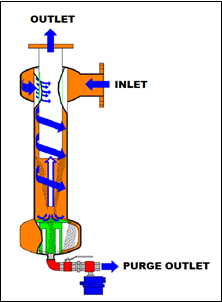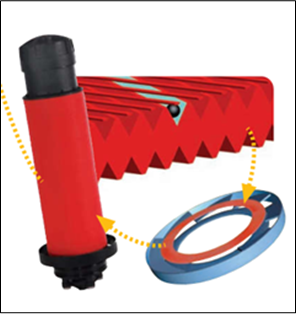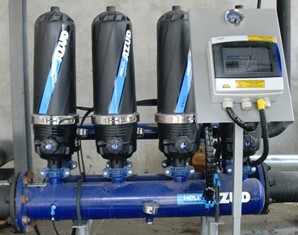Filtration technologies for shallow geothermal systems
Technology and Innovation - good practices
Abstract:
Thanks to geothermal energy utilization, the increasing demand for renewable energy can be lowered. Especially for domestic cooling and heating, which represent almost half of the energy consumption, the use of shallow geothermal energy is considered an environmental friendly alternative to traditional heating techniques. This virtually unlimited source of energy does not require a very hot resource to be effective. On the other hand, a big challenge to operation could be within the geothermal fluid because it can contain many particles differing in size and composition, which can lead to clogging of geothermal unit parts and thus decrease the efficiency of heat transfer in heat exchangers and cause contamination of the re-injection well. Scaling problems and deposits formation may be induced due to dissolution or precipitation of secondary minerals. Geothermal fluids originating from sandy geothermal reservoirs contain large amount of sand particles causing abrasive wear. Therefore, it is important to filter the geothermal fluid flow before it reaches well water pumps and heat exchangers. By using self-cleaning disc filters and separators, these particle-related problems can be avoided or at least considerably reduced. Less maintenance work on all relevant system parts, prolonged lifespan of the heat pumps and heat exchangers, permanently optimal heat transfer and avoided production standstills lead to short amortization times for the protective filters used. A few examples of the application of the filter technology for shallow geothermal energy demonstrate that a correctly selected filter enables a smooth operation of the geothermal units and thus a full exploitation of shallow geothermal energy sector.
Introduction
Ambitious climate targets should help to cut the greenhouse gas emissions and counteract the global warming. Due to the fact that almost half of the energy consumption is spent on heating of buildings and water, a transition from fossil energy sources such as coal, oil, and gas to sustainable energy supply is inevitable. Besides the sun, wind and water power, geothermal energy has potential to cover the heat supply significantly and thus play an important role in the ongoing thermal revolution.
Geothermal energy is heat derived within the sub-surface of the earth and therefore the cleanest and practically inexhaustible source of energy. While deep geothermal applications (about >400 m depth) are specific of a large size, shallow systems (<400 m depth) require no extraordinary geological settings or high geothermal gradients and are mainly based on using low-moderate temperatures for heating and cooling. On average, the temperature of earth´s strata goes up by 3 °C every 100 meters of depth. Depending on the climatic condition of the region and the depth of borehole, average shallow geothermal temperatures providing a basis of heat extraction or heat injection account for 8-12 °C [1].
Shallow geothermal systems ca be classified into ground source heat pump (GSHP) systems of the closed-loop type and groundwater heat pump (GWHP) systems of the open-loop type [2,3]. In case of closed-loop type systems, a heat transfer medium circulates in a closed circuit without direct contact with the aquifer, and heat transfer between the circulation fluid in the collector and the surrounding ground is utilized. By using heat pumps, hot water can be generated while lowering the heat transfer medium temperatures only by a few degrees. During warm seasons, the medium can also be used in reversed mode for cooling by using the ground as a sink for the heat contained within the building.
The heat pump uses electricity to move thermal energy between the building and the ground and condition it to a higher or lower temperature according to the heating or cooling requirements. Consumption of electricity is reduced by 30-60 % compared to traditional heating and cooling systems., allowing a payback of system installations in 2 to 10 years [4]. In open systems, groundwater is pumped from a production well into the system and extracted water is re-injected into another well after the heat exchange. In this so-called doublet system, higher space demand is required to avoid thermal interaction between the wells. In case of small-scale applications, the chilled water is disposed to the surface water or infiltrated by a buried stone bed.
The operation of shallow geothermal pump systems affects the hydrochemical properties of groundwater, therefore a suitable chemical composition of the groundwater source and a well that reaches that water source are critical for a trouble-free operation. Re-injected groundwater at a different temperature from that of the aquifer may induce changes in dissolved O2 and CO2 concentrations, mineral solubility, reaction kinetics, redox processes, and sorption-desorption of dissolved components [5]. Therefore, an open system requires more maintenance than a closed system. Scaling problems such a CaCO3 deposition in heat pumps and heat exchangers result in decreased degree of heat transfer in heat exchangers. Moreover, sand particles act abrasive and cause damages of pump impeller and pump shaft seal leading to frequent standstills and extensive maintenance. Significantly reduced inner diameter of piping, leaking valves or even blocking of wells could endanger the geothermal energy usage. Hence efficient filtration of hot water is inevitable. By using suitable filters and separators, all of these particle-related problems can be avoided or at least drastically reduced. Less maintenance work on all relevant system parts, permanently optimal heat transfer and prevented standstills lead to short amortization times for the protective filters used. Both cyclonic separator and self-cleaning discs filter systems are reliable technologies for keeping the geothermal units clean and protecting heat pumps and heat exchangers. These systems are easy to install and require minimal maintenance.
Filtration systems suitable for shallow geothermal units
- Cyclonic Separation
Cyclonic separators are non-barrier systems using physical forces for particle extraction out of the water stream. They remove particles with a size of above 75 micron and a density of above 2.6 from the fluid up to an efficiency of 99 %. Smaller or lighter particles are also eliminated to a decreasing percentage according to their size and density. For separation of a very fine particles double or triple cyclonic separators can be applied. The separation works reliably and absolutely physically due to centrifugal forces even with a very big quantity of water of 1000 m³ and more. As there are no moveable parts, changes in temperature and pressure do not pose a problem to the system. Furthermore, there is no filtering element to get overgrown and blocked by mineral coatings and coarse particles.
Water enters the separator tangentially on the side so that it forms a rotary motion. Due to the cross-section reduction between the upper chamber und the separation barrel, the rotational speed of water is accelerated as far as an effective separation proceeds up to the necessary efficiency via a centrifugal force. The medium flows down the separation barrel, whereas the contained particles are pushed outside to the barrel wall. The separator is constructed in a cylindrical form to minimize the wearing via an abrasion by particles. On the lower end of the separator, there is a solids collection chamber, which is partly separated from the separation barrel by a deflecting plate. The particles are expelled via a rotary motion through a slot between the separation barrel wall and the deflecting plate from the water stream into the collection chamber. The largely particle-free water stream flows via the pressure gradient to the center of the water swirl, is deflected upwards and leaves the separator through the discharge pipe on the upper chamber.

The solids collection chamber is periodically and time controlled opened to the atmosphere via a valve either manually or automatic in order to sweep the separated particles away. The differential pressure between the system and the atmosphere washes the particle sludge up via a sludge piping out of the system to e.g. sedimentation tank. By this simple emptying via the system pressure, the sludge extraction gets along without any additional engines, pumps, sensors or other failure-hazardous components. The purge valve is the only moving part of the system. In case of a failure of the sludge automatic system, there is no clogging of the water passage and no interruption of the supply of the downstream systems. Only the sludge piping can get clogged and the particles would not be sorted out but they travel with the water flow. In this case there is no clarification of the media. The blow-down takes place during the normal operation and the operation occurs without any interruption.
In contrast to the barrier filter systems (e.g. mesh and sand filters), which are manifesting a rising differential pressure with an increasing extent of clogging, the separator is always characterized by a static pressure loss during the operation. The pressure loss depends only on the flow rate and rises relatively to the flow rate almost linear up to a maximum of 0.8 bar. The abrasion is negligible small and the assumed maintenance free life expectancy of the device accounts for at least 5 years. Thanks to the special concept and the high-performance reliability, it is not necessary to design the system as a redundant system. Due to the absence of barrier, there is a minimal water loss within the system because no cleaning is necessary.
- Automated self-cleaning disc-filters
The AZUD HELIX AUTOMATIC pressure disc filter systems with automatic backwashing have a wide application range within the industrial water treatment sector as well as for general water filtration and application in aquaculture. With a standard filter fineness of 100 μm and a throughput of 20 m3/h/ filter element with a filter surface of 1620 cm2, the filters show an excellent performance in removing particles. Different kinds of particles including even fibrous particles but also dust and organic particles, are reliably removed. The modular design of the pressure disc filter enables customer-specific design and, thanks to individual disc filter elements, an arbitrarily expandable structure. Constructed from corrosion free material, the disc filters are designed for reliability in even the hardest of environment.
The disc filter element consists of a stack of finely grooved plastic filter discs that are pressed onto one another by spring pressure. Due to the special geometry of the grooves on the filter disc, both round and elongated particles are safely retained in the channels on the filter disc surface. The raw water passes from the outside to the inside through the stack of discs through the helix, “an anti-clogging device”, which creates a centrifugal effect. As a result, particles are kept away from the filter discs in a whirling motion and the frequency of backwashing is significantly reduced, minimizing water consumption. Larger particles remain outside on the surface of the stack of discs, while smaller particles are trapped in the grooves. The backwashing is triggered automatically via differential pressure, time, external signal or manually and takes place during the filtration. In this way, the filtrate production is maintained even during backwashing without interruption. The water filtered by the rest of the filters introduces itself to the backwashing filter in the opposite direction. This generates the decompression of the stack of discs thanks to raising the piston. The tangential projection of the water from the inner of the filtering element allows the evacuation of the solids retained by the discs. Compared to the automatic self-cleaning mesh filters, the most important advantage of the disc filters is avoiding of the problem of particles stuck in the mesh after the backwash thanks to the release of the filtering
discs and their thorough cleaning.

The filter fineness of the pressure disc filter can be selected from 5 μm to 400 μm. Even if the system is already installed, it is possible to change the filter fineness by simply exchanging the filter discs. The filter can either be backwashed as a pure water rinse or, for powerful and dynamic cleaning, it can be supported with compressed air (Air Assist version). Maintenance is very simple and can be carried out without any tools.
Filtration technologies for shallow geothermal energy in practice
The disc filter AZUD HELIX AUTOMATIC has been installed in many groundwater heat pump system applications in which the fineness of 100 micron has proven itself as a suitable filter grade. For example, the infrastructure building of the University of Freiburg uses the groundwater heat pump system for cooling. The requirement to the deployed filter was not only an effective protection of the plate heat exchanger against particles, but also the materials the filter is made from cause neither changes in the chemical composition nor favor the microbiological growth of the re-injected groundwater. The AZUD HELIX AUTOMATIC disc filter 206/6FX DLP with a fineness of 100 micron fulfills these requirements completely with minimal maintenance required. A company in Dietenheim producing components for cars and machines is using groundwater filtered by two disc filters AZUD HELIX AUTOMATIC 205/6FX for cooling purposes. An optimized heat transfer increasing the performance of the installation ensures the stability of the production process. Shallow geothermal systems for district heating and cooling of new offices buildings in Munich are using the disc filter AZUD HELIX AUTOMATIC 204/6FX which is responsible for removing particles out of the groundwater and protecting the geothermal unit parts.
The cyclonic separators have been successfully applied in Germany and Austria for numerous well water pumps, which were installed in sandy aquifers and facing problems with large amounts of sand particles inducing abrasion and clogging. The sand abrasion wear to pump impellers and other components was avoided prolonging the pump lifespan by more than five times. Moreover, the pump protection separators help to maintain optimum pump yield, minimize critical pump breakdowns and saves on pump energy costs with higher operation efficiency. An automatic purging unit installed on the purging outlet of the separator allows a safe extraction of the particles even under conditions of high temperature and pressure along with high concentrations of dissolved gases or aggressive compounds.

Outcome
Thanks to the application of right filtration technology in shallow geothermal units, optimal conditions for a trouble-free operation of heat pumps and heat exchangers can be ensured. Both cyclonic separators and disc filters demonstrate an efficient removal of particles out of the fluid stream resulting in prolonged lifespan and increased efficiency of heat pumps, reduced maintenance costs and avoiding of operation downtowns. Shallow geothermal units with appropriate filter technology are economical and energy-efficient technology for space heating and cooling and water heating and an essential renewable energy source in the ongoing thermal revolution.
Sources:
- Bayerisches Staatsministerium für Umwelt, Gesundheit und Verbraucherschutz; Bayerisches Staatsministerium für Wirtschaft, Infrastruktur, Verkehr und Technologie: Oberflächennahe Geothermie, 2005.
- Hecht-Mendez, J.; Molina-Giraldo, N.; Blum, P.; Bayer, P. Evaluating MT3DMS for heat transport simulation of closed geothermal systems. Groundwater 2010, 48, 741-756.
- Kim, H.; Nam, Y.; Jeoun, O.; mu Bae, S. Development of a Multi-Well Pairing System for Groundwater Heat Pump Systems. Energies 2018, 11, 3485.
- https://geothermalcommunities.eu/assets/elearning/6.22.Shallow%20Geothermal%20SYstems.pdf
- Possemiers, M.; Huysmans, M.; Batelaan, O. Influence of Aquifer Thermal Energy Storage on groundwater quality: A review illustrated by seven case studies from Belgium. J.Hydrol.Reg. Stud. 2014, 2, 20-34.



